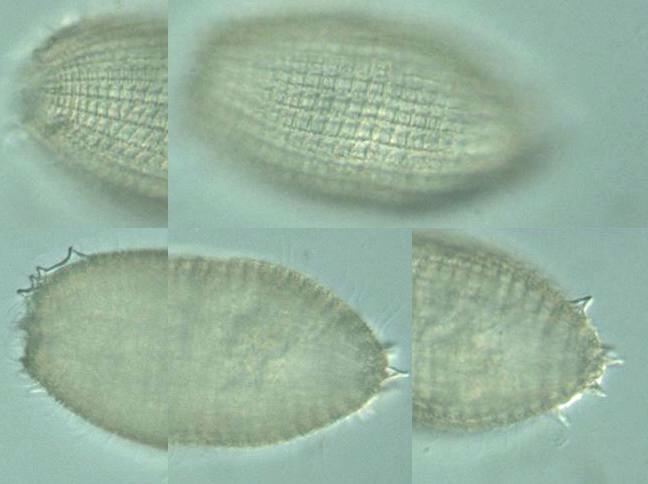

Prostomatea:
Prorodontida: Colepidae
Coleps heteroacanthus
Noland
 Genus: Body form barrel-shaped; with regularly arranged ectoplasmic plates; cytostome at
anterior end, surrounded by slightly longer cilia; often spinous projection at or near posterior end;
one or more long caudal cilia (Kudo, 1966).
Genus: Body form barrel-shaped; with regularly arranged ectoplasmic plates; cytostome at
anterior end, surrounded by slightly longer cilia; often spinous projection at or near posterior end;
one or more long caudal cilia (Kudo, 1966).
Species: Cell body about 90 μm long, 35 μm wide;
anterior spines only one side; posterior spines many (?); caudal cilium present
(Kudo, 1966).
|
Coleps heteroacanthus Noland,
cell body ovoid, 101 μm long, equatorial cleft present,
both caudal and anterior spines present,
x 400, x 640, Vermont-Maine U.S.A., August 7-13, 1999, by Y. Tsukii
 50 μm
50 μm
 100 μm
100 μm
 150 μm; x 400 :
150 μm; x 400 :
 31 μm
31 μm
 63 μm
63 μm
 94 μm; x 640
94 μm; x 640








Coleps hirtus Nitzsch, 1817 (or 1827?):
40-65 μm long;
15-20 rows of platelets; three spines (Kudo, 1966).
60 μm long,
only two (?) posterior spines (How to know the protozoa, 1979);
barrel shaped; 55-65 μm long;
three spines at posterior; a single caudal cilium; each ectpasmic palte has 5 lateral teeth (Carey, 1992).
Coleps elongatus (Ehrenberg, 1830) Kahl, 1930:
Cell body barrel-shaped but rather cylindrical, 65-80 μm long;
a few spines at posterior end; two caudal cilia present;
ectoplasmic paltes ornamented by 2 lateral teeth (Carey, 1992).
Coleps pulcher Spiegel, 1926:
Cell body barrel-shaped or cylindrical; equatorial cleft absent; no caudal cilia;
80-100 μm long;
both caudal and anterior spines present; peribuccal plates with small teeth;
macronucleus large, spherical (Carey, 1992).
Please click on images for viewing enlarged.
Copyright
Protist Information Server
 Genus: Body form barrel-shaped; with regularly arranged ectoplasmic plates; cytostome at
anterior end, surrounded by slightly longer cilia; often spinous projection at or near posterior end;
one or more long caudal cilia (Kudo, 1966).
Genus: Body form barrel-shaped; with regularly arranged ectoplasmic plates; cytostome at
anterior end, surrounded by slightly longer cilia; often spinous projection at or near posterior end;
one or more long caudal cilia (Kudo, 1966).







